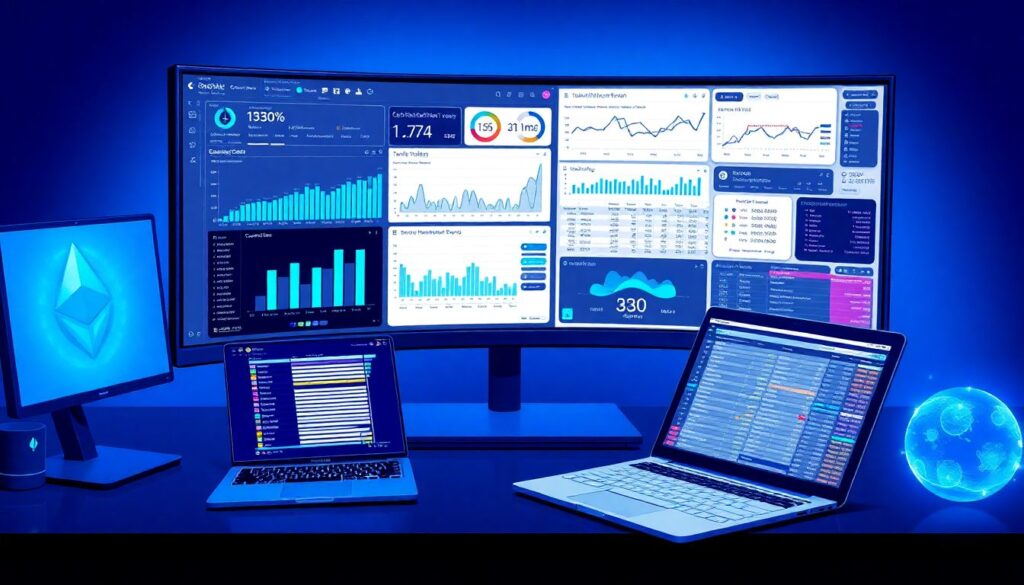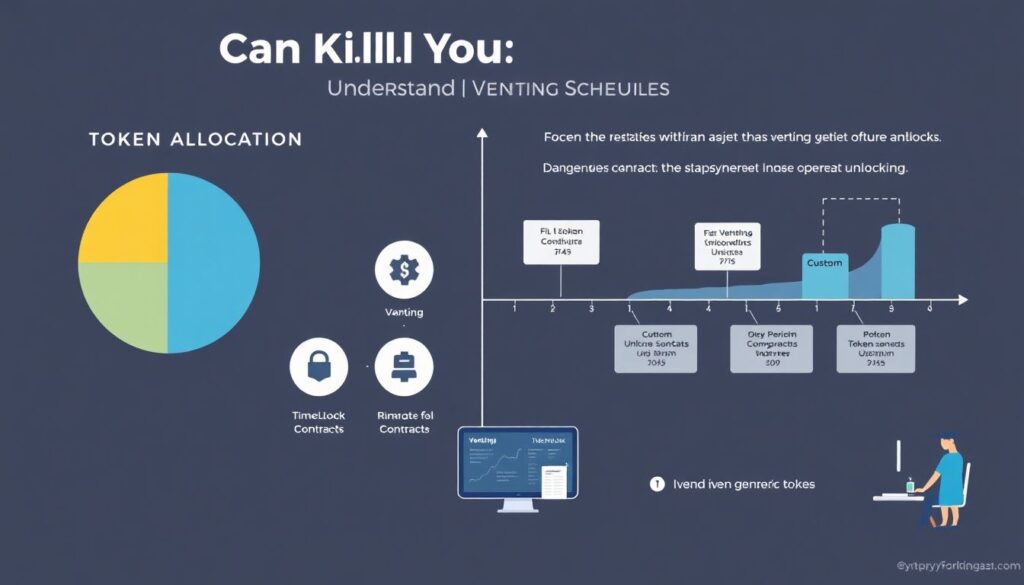Why token distribution safety matters more than hype
Before you throw money at a shiny new token, you need to understand who actually holds it, when they can sell, and how fast supply will hit the market. That’s all the “token distribution model” is: a structured plan for who gets tokens, how many, and on what schedule. If this plan is lopsided or opaque, price manipulation, stealth dumping, and governance capture become much more likely. A solid crypto tokenomics analysis doesn’t just look at charts; it dissects distribution, vesting, and lockups like a risk engineer. Think of it as reading the cap table and shareholder agreements of a startup, but on‑chain and usually with far fewer legal brakes if something goes wrong. Your goal: spot structural dangers before they explode into sudden 90% drawdowns and “we didn’t expect this” excuses from the team.
You don’t need to be a Solidity wizard to do this, but you do need a systematic checklist and some patience. Once you get the hang of it, scanning a token model for red flags becomes as automatic as glancing at order-book depth or trading volume on an exchange.
Necessary tools for real‑world checks

For practical work you’ll mix on‑chain explorers, analytics dashboards, and a few specialized sites. At minimum you want: a block explorer (Etherscan, BscScan, Solscan, etc.), a contract metadata viewer, and a portfolio of dashboards that reveal holder concentration and unlock events. Add a spreadsheet or notebook where you can record allocations, percentages, and dates. This gives you a reproducible process rather than gut feeling. Some platforms provide crypto token risk assessment tools that aggregate things like holder distribution, contract ownership, and code permissions into a single score; treat these as triage, not gospel. You’re building your own token distribution model due diligence workflow, where third‑party tools just speed up the grunt work. Over time you’ll know exactly which indicators correlate with actual blow‑ups and which are just noise.
On top of that, a decent block explorer bookmark setup and a separate browser profile for “research mode” will save you from constant tab chaos and accidental phishing. Keep it boring and methodical.
Step‑by‑step process: from whitepaper to wallet flows
1. Start with the stated tokenomics, then assume nothing
Open the whitepaper or litepaper and find the token allocation section. You’re looking for a breakdown: team, advisors, investors, community, ecosystem, liquidity, treasury. Copy each category, the percentage, and any vesting info into your own notes. This is your “promised distribution.” Now, the important part: assume it may be incomplete, oversimplified, or even misleading until proven otherwise. Many decks simplify curves or omit cliff periods, and almost none highlight edge cases like “team can accelerate vesting via governance vote.” This is where how to evaluate crypto project tokens starts to differ from just reading marketing material; you’re building a hypothesis that you will verify against on‑chain reality. Treat every chart as a pitch, not as a guarantee, and mark any “TBD” or vague category as an explicit risk.
If the project has no clear tokenomics section or hides it behind buzzwords, that alone is a major yellow flag.
2. Verify supply, minting, and ownership on‑chain
Now jump to the contract on a block explorer. Confirm total supply and compare it to the whitepaper. If they don’t match, you need a clear, documented reason (burns, migrations, or upgrades); otherwise, assume trouble. Check whether the token is mintable: does the contract expose functions that allow new tokens to be created, and who controls them? If the owner is an EOA (a regular wallet) rather than a time‑locked multisig or DAO contract, the team can technically mint or reroute allocations at will, regardless of the published schedule. This is where basic safe crypto investment research services, even free ones, can help you quickly flag mint authority, blacklist functions, and pausable transfers. Any central switch that can freeze or reassign tokens is a power that must be justified and time‑bounded, not ignored.
If you can’t find the contract or it’s not verified, step back. Lack of transparency at this level is inexcusable for anything but the tiniest experiments.
3. Map holder concentration and real‑world whales
Holder distribution is where many retail investors get blindsided. Use explorer “holders” views and analytics dashboards to see the top 10, 20, and 100 addresses. Compare those percentages to the published categories: if “community” is supposed to have 50%, but three anonymous wallets hold 35%, you’re not looking at community; you’re looking at concentrated power. Dig into those wallets: are they labeled (exchange, contract, vesting wallet), or just raw addresses? Are they tied to the team’s multisig? Trace a few historical transfers to see if these wallets dump into liquidity pools around key news events. This hands‑on part of crypto tokenomics analysis tells you who can realistically move the market in a single transaction. A token can look decentralized in a pie chart while being entirely at the mercy of three early backers that everyone politely calls “ecosystem partners.”
As a quick rule of thumb, any single non‑exchange wallet holding more than 5–10% of supply deserves extra scrutiny and monitoring over time.
4. Decode vesting, cliffs, and unlock pressure

Even if allocation looks balanced, timing can kill you. Identify vesting contracts: they often have names like “Vesting,” “Timelock,” or “TokenVester,” but sometimes they’re custom. Open them and inspect schedules—either via the contract UI or project docs. Note cliffs (periods of zero unlocks) and then monthly or linear releases. Convert these into a rough emissions calendar: “X% of supply unlocks per month for team,” “Investor tokens fully liquid by month Y.” Then combine this with current market cap and daily trading volume to estimate unlock pressure: if upcoming monthly unlock value is several times higher than average monthly trading volume, you’re staring at a potential dump zone. This is absolute bread‑and‑butter for how to evaluate crypto project tokens in practice: you want to know when structural sell pressure will surge, not just react afterward.
If the project refuses to share detailed vesting data, consider the default assumption that insiders can exit before you.
5. Cross‑check narrative vs. Treasury and utility
Next, look at the treasury and ecosystem allocations. Is there an on‑chain treasury wallet that clearly holds funds, or is “treasury” just a theoretical bucket? See how often the treasury moves tokens and for what: liquidity provisioning, grants, or opaque transfers to fresh wallets. If the token supposedly powers governance or staking, check whether those mechanisms are functional and actually used, or if tokens mostly sit idle in speculative accounts. A distribution model is safer when utility drives demand and tokens are broadly dispersed among active users rather than passive speculators. When in doubt, imagine the project five years out: does this distribution naturally evolve toward more decentralization, or does it lock influence with the initial insiders indefinitely? This is the difference between a sustainable network and a cleverly skinned private equity deal.
A governance token where insiders permanently control every vote is basically equity without the legal protections.
Troubleshooting and stress‑testing your conclusions
Even with a solid process, things will feel fuzzy at first. That’s normal. The key is to iterate: document your initial read, then see how the token behaves over months. Did big unlocks correspond to price shocks? Did supposed “community” allocations actually go to the community, or to market‑making wallets that slowly bled into exchanges? Over time you’ll refine your signal filters. When something feels off—like unexplained spikes in on‑chain volume from a vesting wallet—treat it as a prompt to dig deeper, not a background curiosity. This is also where a lightweight set of crypto token risk assessment tools shines: anomaly alerts, whale‑movement watchers, and unlock calendars can surface patterns you’d otherwise miss. The practical mindset is to treat every new token as guilty until proven structurally sane, especially in early‑stage ecosystems where incentives to dump far outweigh incentives to build.
If your research contradicts the public narrative, trust the chain, not the tweet thread.
When you hit missing data or opaque structures
Sometimes you just won’t find clean mappings between what’s promised and what’s deployed. Maybe vesting is off‑chain via legal contracts, or allocations are blended in omnibus wallets. In those cases, push for answers: ask in public channels, look for audits that mention distribution, and see how team members respond. Stonewalling, vague replies, or “we’ll share later” around key unlocks are strong negative signals. Independent analysts and safe crypto investment research services can be helpful here; they often aggregate interviews, governance proposals, and on‑chain evidence into a more digestible narrative. If, after all that, the picture still looks murky, the safest move is to size your position as if worst‑case scenarios—instant unlocks, surprise mints, insider dumps—are all possible. You’re not owed clarity; projects have to earn your capital by providing it.
Lack of data is itself data: it usually means misalignment somewhere between insiders and everyone else.
Putting it all together in a repeatable checklist
Turn this into a routine: 1) scrape stated tokenomics, 2) verify supply and mint permissions, 3) analyze holder concentration, 4) decode vesting and unlock pressure, 5) inspect treasury behavior and real utility, 6) revisit after major events. Keep short write‑ups for each project, even if you decide not to invest. After a dozen tokens, patterns emerge and your instincts sharpen. The point isn’t to predict every price move, but to avoid structurally unsafe setups: unlimited mint authority, extreme insider concentration, opaque unlocks, and governance captured by a handful of wallets. With a bit of discipline, your personal token distribution model due diligence can rival what professional desks do, just with simpler tooling and smaller size. Over time, the projects that survive your filter are far more likely to match your risk tolerance—and far less likely to blow up for reasons you could have spotted on day one.

